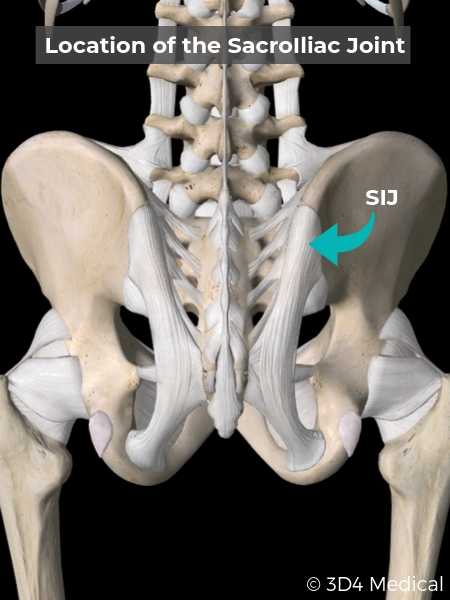What is the Sacro Iliac Joint (SIJ)?
The sacroiliac joints (SIJ) are the 2 joints connecting the lumbar spine to the pelvis supported by strong ligaments and muscles.
Their main function is to absorb shock, provide stability to the pelvis and carry the weight of your upper body to lower extremities, shifting load when standing or walking.
Very small amounts of movement occur between these joints, increased mobility or trauma can create too much motion which may cause abnormal joint position or increased stress resulting in inflammation and increase susceptibility to a sprain.
Similarly, decreased mobility between these joints can lead to pain.
One of the most common complaints we see as Osteopaths are lower back pain – however the source of pain doesn’t always originate from the lower back, when these joints become inflamed or irritated they can cause a sharp pain and often radiate into the lower back and buttocks.
Where Do You Feel SIJ Pain?
Common symptoms of sacroiliac pain or irritation include:
- Lower back pain – ranging from a dull ache to sharp pain and generally more on one side
- Pain around the pelvis or buttocks
- Pain that radiates down the leg, mimicking sciatic pain.
- A feeling of instability in the hips and pelvic
- Pain when going from a sitting to standing position
- Increased pain when putting pressure on sacroiliac joints such as walking, running or lying on one side.
- Symptoms can also imitate a disc bulge with neurological sensation such as numbness or tingling down the legs.

What Causes SIJ Pain?
The sacroiliac joints can become inflamed for a number of reasons; lack of mobility between the joints, trauma, mechanical strain, pelvic instability, arthritis, vigorous exercise and inflammatory disease.
It is extremely common in pregnant women as the hormones released to loosen joints can produce too much mobility in the SIJ joints.
What are the Symptoms of SIJ Pain?
- Lower back pain
- Pain in the hips, pelvis or buttocks
- Groin pain
Pain, numbness and tingling down the legs. - Feeling of pelvic or lower extremity instability, as If something is“giving way”.
- Difficulty sleeping; particularly on the affected side.
- Pain when sitting for prolonged periods and moving from sit to stand position.
What Are Contributing Factors To SIJ Pain?
- Too much or too little motion in the sacroiliac joints
- Weak core muscles
- Muscle imbalances in the pelvis
- Reduced lumbar spine mobility
- Biomechanical abnormalities or a difference in leg lengths
- Poor postural habits
- Occupation i.e. an office job where you’re sitting most of the day
- Lack of physical activity or a sedentary life style
What Else Could Be Similar To SIJ Pain?
SIJ dysfunction symptoms can be similar many other conditions including a lumbar disc bulge, gluteal tendonitis and strain, lumbar facet syndrome, trochantic bursitis, piriformis syndrome, ankylosing spondylitis and ITB syndrome to name a few.
How is SIJ Dysfunction Diagnosed?
Given that SIJ pain can mimic many other conditions, proper diagnosis is vital in managing your problem.
Your Osteopath will use a range of provocation tests on the SI joints, generally we use 5 tests to put pressure through the joints; if these are positive in reproducing your familiar pain we will confirm SI joint dysfunction. Less commonly, we may refer you for imaging.
What Are The Standard Treatments For SIJ Pain?
Once the problem is diagnosed we may use a range of techniques: soft tissue massage, manipulation, dry needling, correcting any imbalance through the lumbar spine, pelvis or hips.
We may provide a program aimed to strengthen the muscles that attach to the SI joints. If the problem is originating from a difference in leg length we can provide you with a heel lift, in some cases we may also prescribe the use of sacroiliac belt.
Additionally we can provide postural and ergonomic advice as well as exercises to increase mobility, core strength and posture.
What Are The Alternative Treatments For SIJ Pain?
Application of heat or ice, core exercise, stretches, NSAIDS and supplements to reduce inflammation such as turmeric may be effective alternative modalities.
Self Help for SIJ Pain? – Things You Can Do Yourself:
- Strengthening and stretching through the gluteal and core muscles.
If you are experiencing SI pain it may be wise to avoid any activities that will put increased stress through these structures e.g. running or contact sports that could further injure the joint until your pain settles. - Limit excessive cycling, lifting or jumping.
- Any exercise or activity that involves a lot of twisting or turning
When would you see an Osteopath about SIJ Pain?
If you are suffering any of the above symptoms book in with your osteopath who can diagnose, treat and help you manage the problem.
